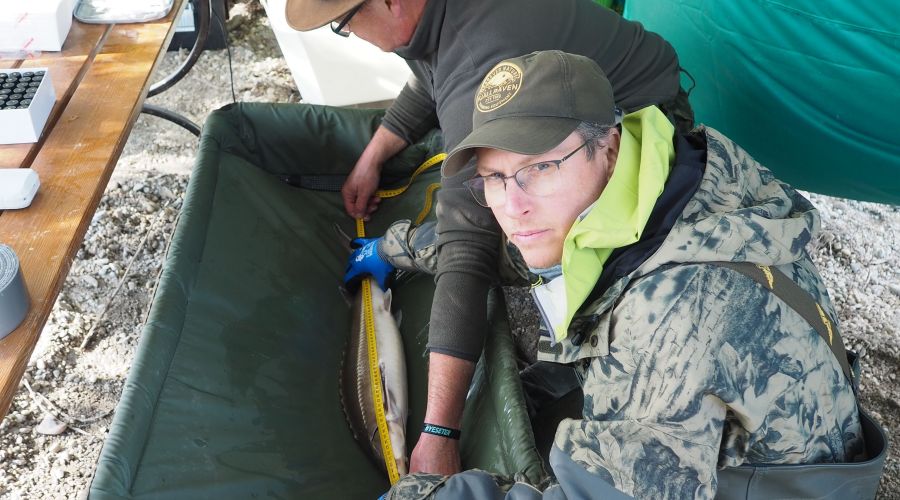Bleeping cartilaginous knights: where do the Danube sturgeons swim and what bothers them?

The Danube River is full of freshwater scaly wanderers, which constantly move during the year, upstream and then back downstream, to their breeding, feeding and wintering sites. Sturgeons, a group of prehistoric cartilaginous fish, are among the largest, lifelong wanderers. Although sturgeons do not have bones, they do have armor on their bodies - dozens to hundreds of calcified scutes and plates that look like medieval armor. Their skull is as hard as a helmet and extends into a rostrum (snout) resembling a short sword. Overall, sturgeons look like medieval knights in full armor riding somewhere to fight. And indeed. They are going to fight. To fight for your own life, for the survival of your species, for the survival of the entire group of sturgeon species. Despite their great travel courage, sturgeons belong to a group of fish whose future lies in the stars thanks to adverse human activities. One of them is the straightening of streams, the construction and operation of barriers on streams, such as weirs, dams, etc. These activities disrupted or completely interrupted the natural migration of rheophilic (current preferring) fish species, including sturgeons.Sturgeons need tens to hundreds of kilometers of free water to live - without weirs, dams or other barriers. Without free-flowing waters, the sturgeons are lost and silently await their end. The biggest migration record holder is without a doubt the beluga (Huso huso), which in the past regularly migrated over a distance of almost two thousand km (Black Sea-Slovakia/Austria). The construction of a system of dams in the Iron Gate Valley on the border of Romania and the former Yugoslavia (today's Serbia) completely stopped the beluga migration. Currently, beluga is waiting for a miracle under the turbines of the Iron Gate hydropower plants. But even the sterlet (Acipenser ruthenus), the last surviving species of sturgeon in the middle section of the Danube (including Slovakia), is not left behind. This species usually needs 100 km of free-flowing water to live, but it can be as much as 300-500 km. After birth (hatching), sturgeon larvae drift downstream tens to hundreds of kilometers to the localities where they will grow, and then in a few years adult sturgeons return home upstream to reproduce. But it doesn't end there. During the year, the sturgeon undertakes regular migrations to search for food, in autumn sturgeon moves to the deepest parts of the stream to overwinter there. And in the spring, it moves back to the spawning grounds to breed. In short, sterlet is always moving, traveling, swimming and is never at rest. Unfortunately, even the sterlet, together with its relatives - e.g. the Russian sturgeon (A. gueldenstaedti) or the stellate sturgeon (A. stellatus) - received a huge blow more than 30 years ago in the form of the construction and operation of the Gabčíkovo barrage system (the Nagymáros part was not completed). The Russian and stellate sturgeons have completely disappeared from the Slovakian-Hungarian section of the Danube, the sterlet is still around, but it is not doing very well here.
At the same time, the sterlet has become the flagship fish species of the Danube River basin, on which, along with the beluga, is the focus of intense international attention. After all, if the life requirements of sturgeons are solved, the whole Danube will be "healed". The Danube can thus become a living river again. And precisely "Living Rivers", a ten-year integrated LIFE project (101069837/LIFE21-IPE-SK-Living Rivers), one of the goals of which is to draw attention to the necessity of adjusting the living conditions of rheophilic fishes (including sturgeon) in the Slovak-Hungarian part of the Danube and further to propose and realize changes in the morphology and passability of rivers for fish migration and to monitor the effectiveness of these changes.
That is why the project partner - the University of South Bohemia in České Budějovice, Faculty of Fisheries and Water Conservation (FFPW USB), started in April 2024 a telemetric study of the migration passability of the Slovakian-Hungarian part of the Danube in the Bratislava-Medveďov section for fish. In total, more than 60 sterlet were tagged, got acoustic transmitter, and released back to the stream to continuously "report" their position in the stream for more than two years. This is made possible by the created net of underwater signal receivers, which are installed on the water structures, but also in free-flowing parts of the Danube. The goal of the activity is to find out as much information as possible about the movement of sturgeons through the project area. To find out where the fishes swim, where they stay, where they cannot swim because they have encountered an impassable migration barrier. Among other things, the "bleeping" sturgeons will thus help us to show how big a problem for their life is the presence and operation of significant migration barriers located in the Slovak-Hungarian section of the Danube - the Čunovo, Gabčíkovo and Dunakiliti water works. No one knows for sure if and where sturgeons could overcome these water structures. In the near future, the “bleeping knights" should be joined by more of their relatives, not only from sturgeons, but also other rheophilic fish species – common barbel and asp.
Written by: RNDr. Bořek Drozd, Ph.D. – coordinator of the LIFE Living Rivers project at FFPW USB



